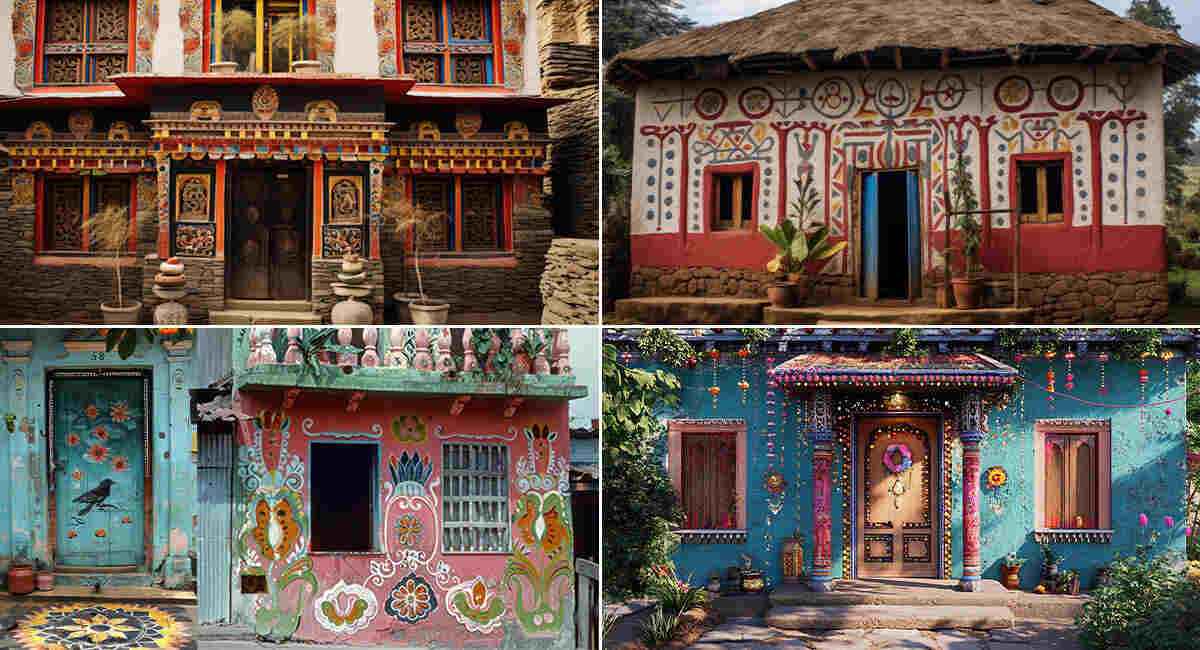Raghurajpur
Hidden amidst coconut groves and lush greenery in the heart of Odisha, India, lies a small village that seems frozen in time — Raghurajpur. This quaint little hamlet, just 14 kilometers from the temple town of Puri, is not your typical rural Indian village. It’s a living gallery, a sacred space where every wall breathes creativity, every home echoes with the rhythmic strokes of brushes, and every path leads you closer to centuries-old artistic traditions.
Raghurajpur is not just a Village, it’s a temple of art.
A Village Born of Art
What makes Raghurajpur unique is its art and how deeply the people embed it in their everyday lives. It is famous for being the birthplace of the exquisite Pattachitra paintings, a traditional scroll painting known for its intricate detailing, mythological narratives, and vibrant natural colors. But Pattachitra is just the beginning.
From delicate palm leaf engravings and stone carvings to Papier-Mâché toys, Gotipua dance (the predecessor of Odissi), and mural paintings, Raghurajpur is a reservoir of Odisha’s rich cultural legacy.
Each family in the village is an artist’s family. Every home doubles as a workshop. The walls of these homes are decorated with murals and motifs — telling stories from the epics of the Mahabharata, Ramayana, and the Jagannath cult. You don’t visit galleries here — the entire village is the gallery.
Pattachitra, The Soul of Raghurajpur
The word Pattachitra comes from “patta” meaning cloth and “chitra” meaning picture. The artists, known as Chitrakars, create these paintings using natural dyes and pigments derived from stones, shells, and organic materials. Artists handmake their brushes, often using hair from their own family — they create art with parts of themselves.
These paintings typically depict mythological tales — Lord Jagannath and his siblings, Radha-Krishna stories, and scenes from the Ramayana — with fine lines, bold colors, and elaborate borders. But more than religious imagery, Pattachitra reflects devotion, discipline, and a sacred connection between the artist and the divine.
The Temple Connection
It is no surprise that Raghurajpur feels like a temple. The artistic practices here are rooted in devotion. For centuries, the Chitrakar community has painted Patas (cloth paintings), which people use during the famous Rath Yatra of Lord Jagannath in Puri. During the Anasara period, when the deities rest after falling ill from the annual chariot ride, devotees place their Pattachitra paintings for public viewing. This blend of religion, art, and culture reinforces the sacredness of the craft and honors the artists who preserve it.
Visiting Raghurajpur, you realize that art is not a profession for the people here. It is a form of worship.
Preservation of a Cultural Treasure
In 2000, Raghurajpur was declared the first heritage village of India by INTACH (Indian National Trust for Art and Cultural Heritage). This recognition wasn’t just honorary; it sparked structured efforts to preserve and promote the village’s traditional art forms. Organizers introduced workshops, cultural programs, and festivals to attract visitors and help sustain the artists.
Thanks to this, Raghurajpur has seen a resurgence in tourism and awareness. Artists now get opportunities to travel, participate in exhibitions, and even teach art abroad. Yet, despite modern exposure, they’ve preserved the essence of their tradition with reverence and pride.
Experience the Village
A walk through Raghurajpur is nothing short of magical.
As you enter the village, the first thing that strikes you is how every house is a canvas. Vibrant paintings adorn walls and doorways. The fragrance of raw materials — tamarind paste, stone powders, and coconut shells — fills the narrow lanes as artisans use them to create the artworks.
Residents will warmly welcome you into their homes, offer you a seat on the floor, and gently show you the intricate process behind the paintings. Children as young as five or six sketch eagerly, while elders patiently teach them techniques passed down through generations.
There is no haggling, no aggressive selling. The artists speak with humility and pride, and the art speaks for itself.
Beyond Paintings, Gotipua, and Performing Arts
Raghurajpur is also the home of the Gotipua dance tradition, a precursor to the classical Odissi dance. In Gotipua, young boys dress as girls and perform devotional dances, often praising Lord Jagannath. Some of the most renowned Odissi dancers, including the legendary Guru Kelucharan Mohapatra, hail from this village.
Many artists here are trained in visual and performing arts, making Raghurajpur a multidimensional hub of creativity.
Why You Should Visit?
In an age of digital art and mass-produced souvenirs, Raghurajpur is a reminder of what it means to create with soul. It offers:
- A deep dive into one of India’s finest living traditions
- An opportunity to meet master artisans in their own homes
- First-hand experiences in art, dance, and rural life
- A spiritual connection with creativity and heritage
Whether you’re an art lover, a traveler seeking authenticity, or someone looking for inspiration, Raghurajpur welcomes you not with a ticket but with open doors and open hearts.
Final Thoughts
Raghurajpur isn’t just a village you visit. It’s a place you feel. With every painted wall, every stroke of a brush, and every note of a Gotipua song, you are reminded that art — when created with devotion — becomes sacred. In Raghurajpur, people don’t just display art — they invite you to experience it. It truly is a temple of art — one that every traveler and art lover should pilgrimage to at least once in their lifetime.


